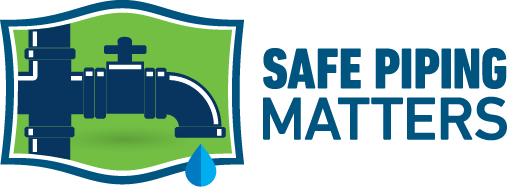Plastic Pipes, Microplastics & Human Health
How Commonly Used Plumbing Materials Contribute to Health Risks
Academic research identifies plastic pipes as a significant source of microplastics (MP) and nanoplastics (NP) in potable water systems. An analysis by Świetlik and Magnucka of water and pipes taken from water-transmission systems in 2023 found that both PVC and PE pipes crack and peel “relatively quickly” as they age, due to interactions between the plastic materials with water and additives used for disinfection.
As the interior surfaces of these pipes degrade, they release particles of plastic into water. When people ingest the MP and NP flaking from plastic pipes, it adds to their already significant exposure to plastic pollution. Recent studies estimate that humans are exposed to up to 883 microplastic particles per day, primarily through drinking water.
Plastic debris in the environment has physical and chemical properties that can create serious health impacts. This report summarizes research on how plastic pipes shed MP and NP and reviews the effects that these particles can have on the gut, lungs, brain, and reproductive systems, along with risk factors for the spread of pathogens and disease.
Microplastics from
Plastic Water Pipes
The presence of some MP and NP in drinking water might be expected, given the prevalence and explosive growth of plastic in the built environment, consumer goods, packaging, and other sources. Correspondingly, plastic pollution levels have increased nearly 700-fold over the past 70 years, rising from 500,000 metric tons in 1950 to 360,000,000 metric tons in 2018.
Existing water-treatment technologies are relatively effective at removing MP and NP contamination from public water sources, raising questions of whether plastic particles may be introduced from plastic piping systems themselves as treated water moves from treatment facilities to points of use.
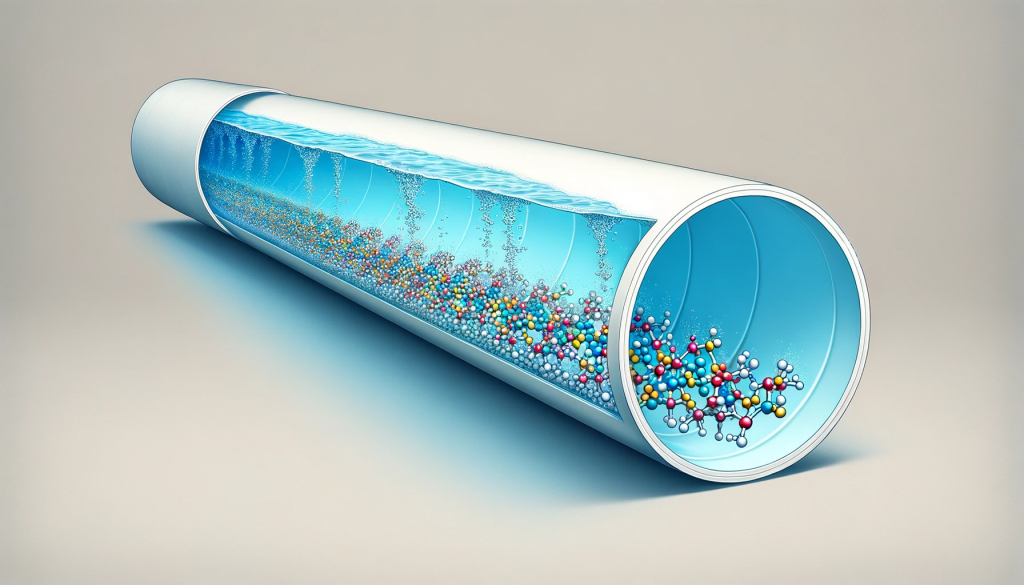
Evidence showing that plastic pipes degrade over time prompted several research teams to examine the degree to which plastic plumbing materials might represent a source of MP & NP in water. Their methods included a straightforward comparison that measured the concentration of MP and NP in water sampled from treatment facilities and compared that value to water samples taken from a point of use. The results found that the number of plastic particles increases as water moves through pipes made of plastic.
About Microplastics & Nanoplastics
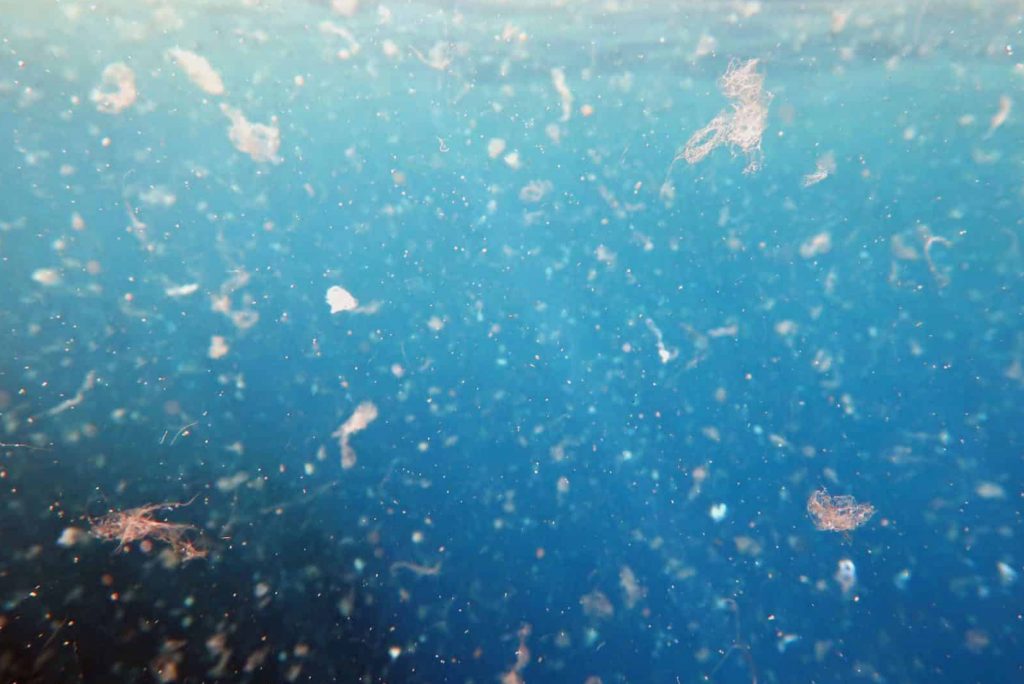 Plastics used in plumbing and other building products include materials such as chlorinated polyvinyl chloride (CPVC), crosslinked polyethylene (PEX), polyethylene (PE), and polyvinyl chloride (PVC). Chemical and physical degradation of these materials during and after use causes them to shed small plastic particles into the environment.
Plastics used in plumbing and other building products include materials such as chlorinated polyvinyl chloride (CPVC), crosslinked polyethylene (PEX), polyethylene (PE), and polyvinyl chloride (PVC). Chemical and physical degradation of these materials during and after use causes them to shed small plastic particles into the environment.
If they are 0.1 microns to 5 mm in diameter, they are microplastics. If smaller than 0.1 microns, they are nanoplastics. The small size, high relative surface area, and inability to dissolve in water amplify exposure to MP and NP.
When MP and NP release from plastic drinking-water pipe, these particles pass to faucets and fixtures, increasing human exposure to plastic compounds, along with chemical additives such as antioxidants, fillers, flame retardants, pigments, plasticizers, and stabilizers.
According to research on plastic leachates published in the journal Case Studies in Chemical and Environmental Engineering, microplastics and nanoplastics increase the rate of “plasticisers leaching, adsorption/desorption of hazardous chemicals and pathogens in water, raising concerns for their eventual negative effect on environmental and human health.”
In other words, the presence of these small plastic particles in drinking water increases concentrations of harmful chemicals and microbes to which people are exposed.
The material properties of plastic make it susceptible to both natural and chemical aging processes. For plastic pipes, interaction with water and disinfection chemicals represents a significant source of aging effects, along with factors like heat and mechanical wear. Microbial activity represented an accelerant, with research finding that metabolic processes carried out by microorganisms that grow and coat the insides of pipes – known as biofilms – “aggravate the material degradation process” of plastic. Each of these aging factors changes the structure and properties of plastics, changing their structure and/or properties in ways that will be described later in this report.
To understand the phenomenon more completely, Świetlika and Magnucka examined mechanisms of MP and NP release from plastic pipes by sampling plastic water pipes from existing systems. They then scanned the pipes to assess “microdamage and exfoliation on the surface of polymers,” including “chemical and biological degradation processes on the interior surfaces of water pipes.” Their analysis showed “micro-damage and cracks” in the plastic pipes used most often for water distribution (PVC and PE) and that the degradation released more nanoplastics than microplastics.
Plastic pipes are made from resins derived from fossil fuels such as oil and gas. The chemical composition of common plastic piping materials – including polyvinyl chloride (PVC), polyethylene (PE), crosslinked polyethylene (PEX), and crosslinked polyvinyl chloride (CPVC) – varies significantly, however. The following sections of this report look at what we know about each of these plastics.
PVC pipes
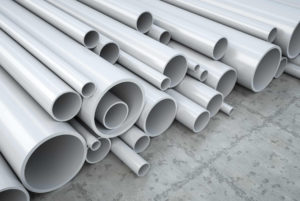 Pipes made of polyvinyl chloride (PVC) have strong and rigid walls, so they can be used in applications that softer, weaker plastics cannot. Main applications include water supply lines and drain/waste/vent applications.
Pipes made of polyvinyl chloride (PVC) have strong and rigid walls, so they can be used in applications that softer, weaker plastics cannot. Main applications include water supply lines and drain/waste/vent applications.
Researchers analyzed microscopic images of PVC pipe showing extensive pitting and holes along with fine, torn plastic particles on the inner surface of the pipe walls. They found these wear patterns regardless of the pipe age or diameter, with “peeling and detachment of the polymeric material,” forming NP that were released into the distributed water.
Types of damage varied depending on the diameter of the pipe. Wider pipes mainly showed “deep pits around which peeling areas and plastic particles were visible.” By contrast, small-diameter pipes showed numerous particles and fragments of torn material. Since these smaller pipes are mainly found near the ends of water distribution networks, including within homes, they can “significantly” expose consumers to “unwanted microplastics… via tap water.”
The increased irregularity and porosity of the polymer was also found to harbor mineral deposits and dense biofilms. The growth and waste byproducts from microorganisms can biodegrade pipe structure and impact quality of distributed water.
Teams also identified other byproducts of PVC-water interactions in water, including the following:
- Aldehydes – A family of compounds that are carcinogenic and toxic, irritating the eyes, nose, skin, and throat, and impacting the heart, kidneys, lungs, and nervous system.
- Dibutyl phthalate – This chemical can cause eye, nose, and throat inflammation and damage the liver and kidneys with long-term exposure.
- Organotins – Persistently toxic substances that can disrupt and damage the endocrine system, immune system, liver, nervous system, and reproductive organs.
- Vinyl chloride – This chemical is carcinogenic and can irritate the eyes and respiratory tract and damage the heart, liver and nervous systems. It was a major source of contamination at the disaster in East Palestine, Ohio.
Polyethylene Pipes
Polyethylene (PE) pipes feature good material strength compared to other plastics but have a brittle structure that requires additional care to minimize risk of impact damage.
Further, expansion and contraction of PE due to temperature fluctuations is significant over long pipe runs, requiring allowances in the design to ensure system integrity. This pipe is often used for potable water and gas transport applications.
As noted above, the study from Świetlik and Magnucka found that environmental, chemical, and biological factors can degrade the surface and structure of PE pipes. Such damage emerges as wrinkles on the inner surface of pipe with most damaged areas comprising “fragments of peeling antioxidant coatings and polyethylene itself.”
Most common contaminants from PE pipes included the following:
- Aldehydes, ketones, and esters – These compounds have a range of health impacts, including increasing cancer risk, irritating skin and mucous membranes, and impacting reproductive function including reductions in sperm count.
- Aromatic hydrocarbons – These compounds include carcinogens such as benzene. Studies of impacts on water quality following fires have found levels up to 40,000 times the legal limit in water systems.
- Phenols – These compounds are considered “quite toxic to humans via oral exposure,” with impacts on internal organs, as well as reproduction and fetal development.
- Quinones – These compounds are not only carcinogenic, but also genotoxic (meaning they change how DNA replicates and functions in a cell). Chronic exposure can also cause eye and skin irritation.
- In addition, researchers found that the dissolution of coatings and pipe materials provided growth habitats and food sources for microorganisms within the system.
Leaching of these chemicals may help explain complaints about the taste and odor of water supplied through PE pipes. Taken together, these health and quality factors make it clear more study is needed to assess the safety of PE as a piping material.
CPVC Pipes
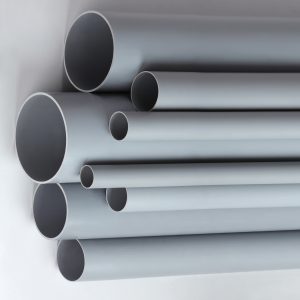 CPVC (chlorinated polyvinyl chloride) pipe is used in hot- and cold-water distribution systems, as well as in sprinkler systems used for fire protection. It can withstand higher temperatures than PVC pipe, but its susceptibility to chemical damage is significant – many manufacturers provide lists of substances that must not be used on or near such pipe.
CPVC (chlorinated polyvinyl chloride) pipe is used in hot- and cold-water distribution systems, as well as in sprinkler systems used for fire protection. It can withstand higher temperatures than PVC pipe, but its susceptibility to chemical damage is significant – many manufacturers provide lists of substances that must not be used on or near such pipe.
The chemical makeup of CPVC means its performance in use could be similar to or worse than its PVC cousin. It may also produce byproducts from interactions with water and chemicals used to suppress microbial growth:
- The use of chlorine to disinfect water delivered by CPVC pipes has also raised concerns. According to ecotoxicologist Jane Muncke: “When you… use chlorination to disinfect your drinking water, you’ll have a lot of chlorinated chemicals floating around in your drinking water.” Chlorine-derived chemicals of concern include trihalomethanes and haloacetic acids, both of which have toxic health effects such as damage to the kidneys, liver, lungs, and mucous membranes.
- CPVC discolors and becomes more susceptible to fractures when exposed to UV light, so its use outdoors should be limited.
- CPVC pipe is susceptible to damage from incompatible chemicals, including many common materials used for building construction and maintenance, including firestopping compounds, fungicides and/or mold inhibitors, dishwashing liquids, HVAC lubricants, and many others listed by manufacturers.
PEX pipes

PEX (cross-linked polyethylene) pipes are often used for interior applications because they are easy to install, flexible, able to handle a range of temperatures, and expand/contract less with temperature changes than some other plastics.
- A 2014 study found PEX pipes release 11 volatile organic chemicals, including toluene, ethyl-tert-butyl ether, and other contaminants, when they interact with water and water-treatment substances. The leached chemicals – whose health effects are not fully understood – are present in highest concentrations in the first months after installation. Until these substances get flushed away, this water may be contaminated with “acetone, wax, or plastic” tastes and/or odors coming from the PEX materials.
- Over the longer term, researchers who studied how “the mechanical properties and lifetime of PEX were reduced after exposure to chlorinated water” concluded that “on the basis of aging mechanisms and material performance characteristics, we propose that MPs and/or NPs can be leached from aging pipes.” Researchers have not yet assessed the type and quantity of particles released, however.
- Like CPVC, PEX is sensitive to damage from UV light. This type of plastic may also allow permeation of chemicals through the pipe walls into water passing through the pipe.
Health Impacts
Overview
As levels of MP and NP particles rise in the environment, their effects on health raises concerns among medical professionals. A growing body of research finds NP and MP particles across a wide range of animal organs, including the gut, lungs, brain, and reproductive systems. The impacts they are finding include possible degradation of organ function and associated impacts on overall health. The chemical and physical characteristics of MP and NP can also carry other substances and organisms that adhere to the particles, amplifying the reach and concentrations of harmful environmental and biological pollutants. The next sections of this report examine research looking at the effects of MP and NP on critical bodily systems.
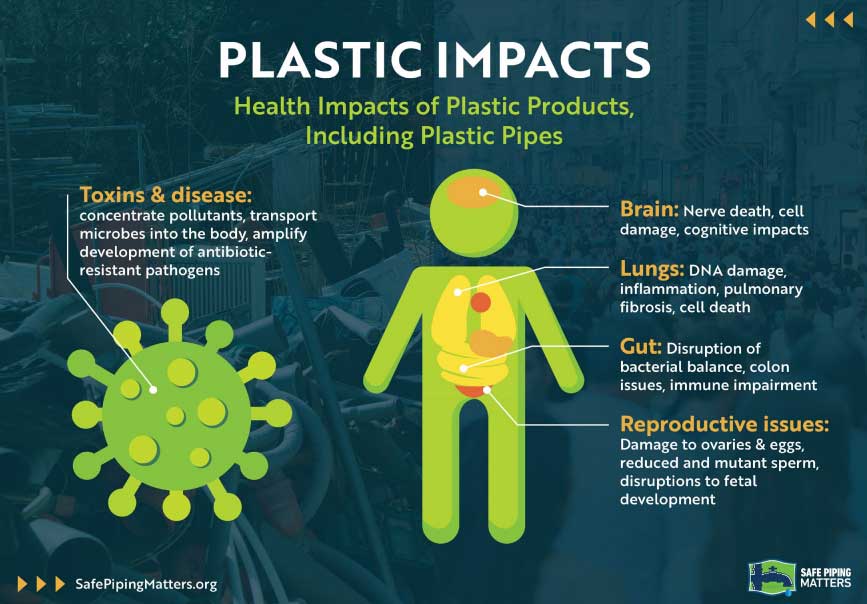
How Plastics Can Affect Gut Function
Direct ingestion of MP and NP contamination in beverages including drinking water represents a primary source of human exposure. A 2018 study from the University of Minnesota found plastic particles in 81% of samples taken from a range of international metropolitan centers, and a review of over 400 data points across 26 studies estimated that those who drink only tap water ingest about 4,000 particles per year from this source. For those who drink only bottled water, the amount jumps to 90,000 particles per year. The same study estimates that an average American consumer ingests 39,000 to 52,000 MP and NP particles per year from food.
Much more research is needed, but lab studies have demonstrated significant effects of MP and NP particles on gut function, including:
- Changing the ecology of bacteria in the gut, inducing metabolic shifts and disrupting the balance and numbers of microbes in the gut. This effect – called dysbiosis – can lead to issues such as cancer, cardiovascular problems, diabetes, irritable bowel syndrome, and obesity. Studies of planarian flatworms exposed to plastics also found oxidative stress, enzymatic changes, and changes in bacterial populations and activity compared to healthy individuals.
- Disruption of the intestinal epithelia, a filtering mechanism that controls what can pass into the body from the digestive system. A well-functioning intestinal epithelium will accept what it deems useful and keep harmful matter out. Studies find that MP and NP affect the mucus secretions of the gut as well as the number of neutrophils (white blood cells) present.
- Impairing the immune function of microphage cells, another protective mechanism of the gut. Microphages police the gut, absorb contaminants, and help expel them from the body. Exposure to plastic particles induced metabolic changes in these cells that may indicate increased oxidative stress and can trigger intestinal dysfunction.
- Potentially damaging the mucus layer of the colon, which may contribute to early-onset colorectal cancer by “reducing its protective effect.” Another study found disruption of the colon epithelium accelerated development of colitis, triggering “severe bodyweight loss, diarrhea, bloody stools, macroscopic and pathological damage, and inflammation levels.”
How our bodies deal with MP and NP particles that pass into our digestive systems may depend on their size. The European Food Safety Authority concluded that the body excretes 90% of particles larger than 150 microns into fecal matter. By contrast, an earlier study showed roughly a third of 50 micron particles were absorbed by the gut, then moving throughout the body, including to the blood, marrow, liver, and spleen.
How Plastics Can Affect Lung Function
The low weight of MP and NP particles allows them to spread easily through the air. A 2023 study assessing plastic pollution in rain clouds found significant concentrations of MP and NP particles ranging from 6.7 to 13.9 pieces per liter, adding to evidence that airborne plastic pollution is a global phenomenon. Research also finds MP and NP contamination levels are especially prevalent in homes, workplaces, and public spaces. Estimates of inhalation exposures range up to 90,000 particles/year. A 2022 study detected plastic particles in 11 of 13 human lung tissue samples, with the highest concentrations found in lower portions of the lungs.
Studies of health effects continue, but research is currently investigating impacts of MP and NP particles on lung function such as the following:
- Damage to lung cell DNA, indicated by “breakage of chromosomes or whole chromosome loss,” associated with genotoxic impact on cells.
- Measurable increases in the number of cytokines, proteins that work to fight infections and inflammation, which has been shown to exacerbate chronic lung conditions such as COPD and asthma.
- Higher levels of reactive oxidative stress in lung cells, a reaction associated with development, proliferation, and metastasis of cancer.
- Physical damage to lung tissue, including pulmonary fibrosis similar to effects seen in humans suffering from occupational lung diseases associated with exposure to airborne plastic fibers.
- Acceleration of apoptosis (programmed cell death) and other cytotoxic (cell-killing or cell-damaging) effects. This same study concluded MP and NP are capable of overcoming barriers in the body “to penetrate and accumulate in organs and tissues.”
How Plastics Can Affect Brain Function
A study of neurotoxic effects of plastic particles outlines several possible uptake pathways that expose the brain to MP and NP, including inhalation and gastrointestinal absorption. After passing through the gut or lungs, particles translocate into the blood and pass through the Blood-Brain Barrier (BBB). Modeling the mechanisms by which MP and NP enter the brain remains in early stages, though laboratory research with rats and fish shows it does occur. The process can be surprisingly fast, with one study of mice showing NP entering the brain within two hours of ingestion. Variables such as particle size, chemical composition, and a “protein corona” effect may all influence the degree of microplastic absorption through the BBB.
Once plastic particles are inside the brain, research has found several effects on cognitive function and brain health:
- Nanoplastics in the brain activate microglia, cells critical to maintenance of brain tissue that look for plaques and damaged neurons and synapses. This activation likely causes neurotoxicity as the microglia work to eliminate the foreign particles.
- Disruption of “cognitive function and short-term memory impairment” due to ingestion of plastic particles. Removing the exposure to MP and NP allowed the brain to recover.
- Increases in oxidative stress that can damage cells and increase their “vulnerability to develop neuronal disorders,” including ALS, Alzheimer’s, Huntington’s, and Parkinson’s.
How Plastics Can Affect Reproductive Systems
As with the brain, reproductive organs get exposed to plastic particles that enter the body via the gut and lungs, passing through the bloodstream and into the testes and ovaries. Structured animal research has found that MP and NP may accumulate in these areas, where they impact the quality and function of reproductive cells. In humans, researchers worldwide are observing disturbing declines in sperm counts and female fertility, as well as increases in fetal development problems. Studies of reproductive impacts of MP and NP exposure include:
- “Microstructural and functional damage to ovaries,” including oxidation effects, reductions in follicle development, and hormonal imbalances. Reduced ovarian capacity and negative impacts on oocytes, the cells that produce ova.
- Increases in structural defects of sperm, including “two-tailed, hookless, or swollen neck deformities.”
- Identification of MP in human placental tissue, with researchers hypothesizing that MP may affect cellular pathways in the placenta in ways that could increase rates of “adverse pregnancy outcomes” including “preeclampsia and fetal growth restriction,” due to interruptions caused by MP on mechanisms regulating cell growth and development.
- Endocrine-disrupting chemicals released from microplastics. This disruption can directly impact fetal neurodevelopment, one factor that may contribute to a global increase in autism, attention disorders, childhood depression, dyslexia, and other disorders.
- MP and NP that cross the placenta barrier “adversely affect embryonic brain-like tissue development.”
How Plastics Can Increase Exposure to Toxins and Disease
Concentrations of MP and NP are increasing in the air as well as in aquatic and terrestrial environments worldwide. Research shows the chemicals in plastic particles can react with other compounds – such as persistent chemicals and pollutants, heavy metals, and biological pathogens – especially in water. When organisms (including humans) ingest contaminated water or food, the plastic particles serve as a vector for these other substances, creating the potential for harmful exposure and bioaccumulation.
The specific type of plastic particle, the chemicals they contain, and their age all affect the degree to which MP and NP absorb and release contaminants. In general, older and softer plastics can host more such contaminants by absorbing them. By contrast, harder (more crosslinked) plastics tend to interact through weaker adsorption processes, more easily releasing the contaminants.
Research into these effects finds a wide range of potential impacts:
- As plastic particles age in the environment, they undergo physical and chemical changes that “increase their affinity for other, more dangerous compounds, among them metal ions” such as lead, titanium, silicon and iron, as well as metalloids like arsenic.
- Plastic particles attract persistent organic pollutants, including neurotoxic hexachlorocyclohexanes and dangerous forever chemicals like per- and polyfluorinated alkyl substances (PFAS). Concentrations of such pollutants on MP can range up to six times higher than found in the surrounding environment.
- Plastic particles also readily interact with hydrophobic organic chemicals like PCBs (polychlorinated biphenyls) and PAHs (polycyclic aromatic hydrocarbons) that are both toxic and carcinogenic.
- Plastic particles in soil – from landfills to farms and beyond – can become “selective artificial microhabitats” that “accumulate certain opportunistic human pathogens, such as cryptococcal and Phoma-like species” that will lead to pneumonia if they infect the lungs or meningitis if they infect the brain.
- Plastic particles may amplify development of antibiotic-resistant pathogens. They acquire biofilms that represent “a potential hotspot for the horizontal gene transfer (HGT) of antibiotic resistance genes (ARGs).” Biofilms on MP accelerate the production of ARGs by up to 1,000 times compared to natural substrates.
What Should Be Next?
The studies reviewed above show the serious ways in which MP and NP particles impact the human body, from causing changes in the gut and lungs, to triggering further effects in the brain and reproductive systems that have potential to affect human health adversely. Many other research studies are looking at additional issues, including carcinogenic and genotoxic effects on humans and other animals, as well as harm to plants and other organisms. Researchers still do not fully understand how MP and NP affect the body, but the existing body of evidence suggests that following the precautionary principle is warranted with regard to plastics.
While treatment systems limit transmission of MP and NP from drinking-water sources, contamination that enters the system after that point remains largely unmonitored and unmitigated. The research showing that MP and NP shed from plastic plumbing materials poses a question: How can we reduce ingestion of these harmful particles? Adding a filter at point of use is one option. Replacing aging plastic pipe with alternative materials such as copper, cast-iron, or other proven materials is another option. An upcoming report will give a comprehensive view of the possibilities.
